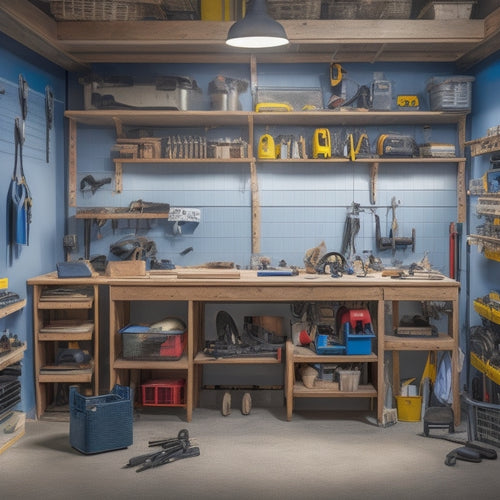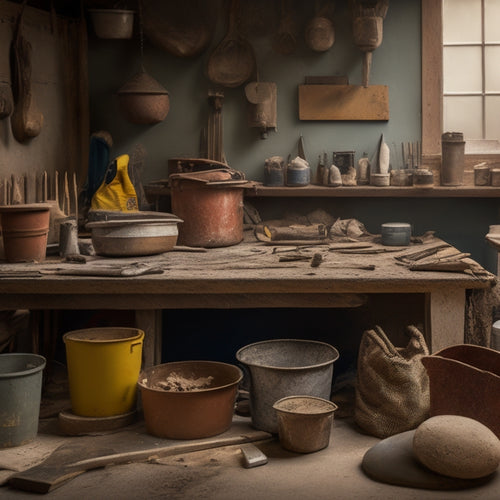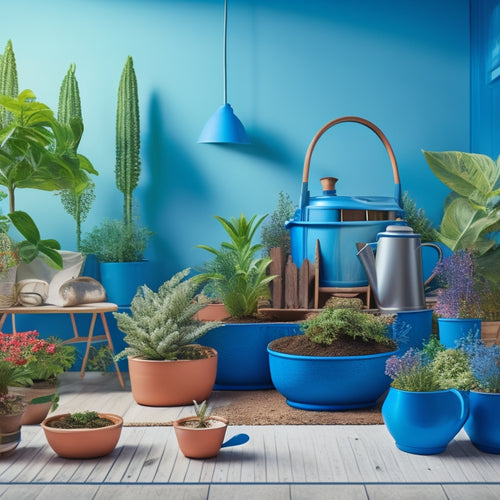
Essential Tools for Plaster Wall Renovation Beginners
Share
You'll need a thorough set of essential tools to tackle a plaster wall renovation, as having the right tools can make all the difference between a successful project and a costly, time-consuming mess. Start with safety gear like hard hats, steel-toed boots, and respirators to protect yourself from hazards. Then, invest in measuring and marking tools, scraping and removing tools, and cleaning and preparing tools to guarantee a smooth surface for renovation. Don't forget plaster mixing and applying tools, smoothing and finishing tools, and specialized repair tools to achieve a professional finish. With the right tools, you'll be well on your way to a successful renovation.
Key Takeaways
- Essential safety gear, including head, foot, eye, respiratory, and hand protection, is crucial for a safe renovation process.
- Measuring and marking tools, such as tape measures, marking gauges, and levels, ensure accurate and professional finishes.
- Scraping and removing tools, including putty knives, wire brushes, and demolition scrapers, are necessary for removing old plaster and debris.
- Cleaning and preparing tools, such as vacuum cleaners, dusting brushes, and containment barriers, help maintain a tidy workspace and prevent mess.
- Mastering techniques for plaster mixing, applying, smoothing, and finishing, along with having the right specialized repair tools, is vital for achieving a high-quality finish.
Essential Safety Gear
Your hard hat and steel-toed boots are about to become your closest allies as you commence on a plaster wall renovation project. Don't even think about stepping onto the job site without them.
As you prep for the renovation, remember that personal protective equipment (PPE) isn't optional - it's a must-have. Head protection is essential, as falling debris or tools can cause serious injury. Your hard hat will be your first line of defense, so choose one that meets industry standards.
Next, protect your feet from heavy objects and sharp edges with steel-toed boots. Make sure they're waterproof and slip-resistant to prevent accidents on wet or oily surfaces.
Don't forget about eye protection - safety glasses or goggles will shield your peepers from dust, debris, and chemical splashes. A dust mask or respirator will keep you breathing easy, while gloves will provide grip and protection for your hands.
With your safety gear in check, you'll be ready to tackle that plaster wall renovation project with confidence.
Measuring and Marking Tools
When renovating a plaster wall, you'll need accurate measurements to confirm a professional finish.
You'll rely on tape measures to take precise readings, marking gauges to create consistent markings, and levels to guarantee accuracy.
Tape Measures Matter
Measuring and marking tools lay the groundwork for a successful plaster wall renovation, and among these, tape measures take center stage. You'll be using them to measure everything from the width of your walls to the distance between studs, so it's crucial to choose the right one.
You'll find various tape types, including fiberglass, steel, and hybrid tapes. Fiberglass tapes are lightweight and flexible, making them perfect for tight spaces, while steel tapes are more rigid and suitable for longer measurements.
When it comes to tape length, you'll typically find 16, 25, or 33-foot options. If you're working on a smaller renovation, a 16-foot tape might suffice, but for larger projects, a longer tape will give you more flexibility. A 33-foot tape will allow you to measure longer distances without having to reposition the tape, saving you time and effort.
Regardless of the type or length, a good tape measure should have clear, bold markings and a sturdy hook that can withstand rough handling. With the right tape measure in your toolkit, you'll be well on your way to measuring up to a successful plaster wall renovation.
Marking Gauge Essentials
How accurately can you transfer precise measurements to the wall without a reliable marking gauge? Not very, if we're being honest. A marking gauge is a vital tool for plaster wall renovation, guaranteeing your markings are precise and consistent.
This handheld tool allows you to create a series of evenly spaced markings on your wall, making it easier to install plaster, drywall, or paneling.
When choosing a marking gauge, consider the type of marking materials you'll be working with. Will you be using a pencil, marker, or even a scoring tool? Different gauges cater to specific marking techniques, so it's important to select one that suits your needs.
Look for a gauge with adjustable spacing and a sturdy build to guarantee accuracy and durability.
With a reliable marking gauge, you can achieve professional-looking results without the hassle of manual measurements. It's a simple yet effective tool that'll save you time and frustration in the long run.
Leveling Up Accuracy
Can you rely on your eyes alone to confirm perfectly level lines and precise markings on your plaster wall renovation project? Think again! Even the most skilled DIYers know that accuracy is key, and that's where measuring and marking tools come in.
To level up your accuracy, you'll need a combination of precision techniques and leveling methods. Start with a good old-fashioned spirit level, which confirms your lines are straight and your surfaces are even.
But don't stop there! A laser level takes it to the next level (pun intended), projecting a precise line or dot onto your wall. For more intricate measurements, a digital caliper is your best friend, providing accurate readings to the nearest thousandth of an inch.
And when it comes to marking, a fine-tip marker or a precision pencil will help you create crisp, sharp lines. With these tools in your arsenal, you'll be well on your way to achieving professional-looking results that will make your plaster wall renovation project shine.
Scraping and Removing Tools
With the old plaster wall exposed, you're ready to tackle the task of scraping and removing the damaged or deteriorated sections. This is where the magic happens, and you get to uncover the underlying structure of your wall.
But, before you start, make sure you've got the right tools for the job.
Here are the scraping and removing tools you'll need:
-
Putty knife: A sturdy putty knife is perfect for scraping off loose plaster and debris. Its curved blade allows for smooth, even strokes, and its flat edge is great for prying off stubborn chunks.
-
Wire brush: A wire brush is your go-to for removing old adhesive, grout, or other residue. Its stiff bristles will scrub away at even the toughest substances, leaving your wall surface smooth and clean.
-
Demolition scraper: When it's time to get aggressive, a demolition scraper is your best friend. Its heavy-duty blade is designed for heavy scraping and removal, making quick work of even the most damaged areas.
Mastering these scraping techniques and removal methods will make the renovation process a whole lot smoother.
Just remember to work carefully and methodically to avoid damaging the surrounding areas.
Cleaning and Preparing Tools
When renovating a plaster wall, you'll need to gather the right cleaning and preparing tools to guarantee a smooth process.
First, you'll require dust removal essentials, such as vacuum cleaners and dusting brushes, to clear away debris and prevent it from spreading.
Next, you'll need surface scrubbing tools, like wire brushes and scrubbers, to remove stubborn grime and old adhesives, and debris containment methods to keep the work area tidy and organized.
Dust Removal Essentials
Dust removal is a crucial step in plaster wall renovation, and having the right tools for the job is indispensable.
You'll be dealing with a lot of debris, and proper dust control techniques will save you (and your lungs) from a world of trouble.
Invest in these must-haves to keep your workspace clean and your project on track:
-
HEPA-filter vacuum system: Don't bother with anything less. A high-quality vacuum with a HEPA filter will capture 99.97% of particles as small as 0.3 microns, guaranteeing you're not just moving dust around.
-
Dustless sanding system: This nifty tool connects to your vacuum and captures dust as you sand, keeping your air clean and your floor clear of debris.
-
Dust mask or respirator: Even with excellent vacuum systems, some dust will still escape. Protect yourself with a reliable dust mask or respirator to avoid inhaling harmful particles.
With these essentials, you'll be well-equipped to tackle dust removal like a pro and guarantee a successful plaster wall renovation.
Surface Scrubbing Tools
Beyond the dust removal stage, you'll need to tackle the surface scrubbing phase, where thorough cleaning and preparation of the plaster wall are essential.
This is where you get up close and personal with your wall, using scrubbing techniques to remove dirt, grime, and old adhesive residue. For this, you'll need the right surface scrubbing tools.
A stiff-bristled brush or a scrub brush with synthetic bristles is perfect for tackling rough surfaces. For more delicate areas, a soft-bristled brush or a non-abrasive scrub sponge will do the trick.
Debris Containment Methods
Now that you've thoroughly scrubbed your plaster wall, you're ready to contain the debris and prepare your cleaning tools. This vital step guarantees you don't spread the mess around and makes cleanup a whole lot easier.
Debris containment is key to a successful plaster wall renovation. You don't want dust and debris spreading to other areas of your home or workspace.
To achieve this, you'll need the following:
-
Containment barriers: These are fundamentally plastic or fabric sheets that you drape around the area to contain the mess. They come in various sizes, so choose one that fits your space.
-
Debris bags: These are heavy-duty bags designed to hold all the debris and dust from your renovation project. They're usually made of thick plastic and have a secure closure system to prevent spills.
-
Drop cloths or tarps: These are waterproof or water-resistant sheets that protect your floors and furniture from dust and debris. They're vital for keeping your workspace clean and tidy.
Plaster Mixing and Applying
Mixing plaster to the correct consistency is essential, as it directly affects the final product's quality and longevity. You're aiming for a smooth, creamy mix that's not too runny or too thick. If you're new to plastering, it's easy to get it wrong, but don't worry, with practice, you'll get the hang of it.
To achieve the perfect consistency, start by slowly adding water to the plaster powder, mixing constantly with a drill and mixing paddle. You'll know it's right when it resembles thick paint or whipped cream.
When it comes to mixing techniques, there are a few tricks to keep in mind. Always mix in small batches to avoid wasting material, and make sure to scrape the sides and bottom of the bucket to incorporate all the powder.
Mix in a circular motion, applying gentle to moderate pressure. Avoid over-mixing, as this can introduce air pockets and weaken the plaster.
Smoothing and Finishing Tools
As you've successfully applied the plaster to the wall, it's time to focus on achieving a smooth, even finish.
Now, it's all about mastering those smoothing techniques to get the desired result. You'll need the right tools to add the finishing touches to your plaster wall renovation.
Here are the essential smoothing and finishing tools you'll need:
-
Trowel: A sturdy, high-quality trowel is a must-have for smoothing out the plaster. Look for one with a comfortable grip and a flat, wide blade.
-
Float: A float is used to remove excess plaster and create a smooth surface. You can choose from various types, including wooden, plastic, or metal floats.
-
Sandpaper: Once the plaster is dry, use sandpaper to remove any remaining imperfections and achieve a silky smooth finish.
Specialized Repair Tools
Behind every successful plaster wall renovation lies a set of specialized tools designed to tackle common issues that can arise during the process. You'll encounter cracks, holes, and uneven surfaces, and that's where these specialized repair tools come in.
For instance, a plaster scraper is a must-have for removing old, damaged plaster and creating a smooth surface for new applications. A plaster claw is another essential tool that helps you remove loose or damaged plaster without causing further damage to the surrounding area.
When it comes to plaster repair, having the right tools can make all the difference. A good-quality plaster trowel is perfect for applying and smoothing out new plaster, while a joint knife is ideal for scraping and smoothing out joints.
Don't forget about tool maintenance – regular cleaning and sharpening will guarantee your tools remain in top condition. By investing in these specialized repair tools, you'll be well-equipped to tackle any plaster repair job that comes your way.
Additional Handy Tools
You've assembled a solid arsenal of specialized repair tools, but there are additional handy tools that'll complement your plaster wall renovation efforts.
These extras mightn't be essential, but they'll make your life easier and your results better.
-
Dust mask and safety glasses: You'll be generating plenty of dust and debris, especially when sanding or demo-ing old plaster. Protect yourself from inhaling nasty stuff and getting particles in your eyes.
-
Laser level: Ensuring your walls are straight and level is vital for a professional-looking finish. A laser level helps you achieve that perfect plane, which is especially important when applying wall texture techniques.
-
Paint swatch fan deck: With so many plaster color options available, it's easy to get overwhelmed. A paint swatch fan deck helps you visualize and compare different hues, making it simpler to choose the perfect shade for your renovated walls.
Frequently Asked Questions
Can I Use a Regular Vacuum for Dust and Debris Cleanup?
You'll want to ditch your regular vacuum for dust and debris cleanup, as it's not designed for heavy dust collection. Instead, opt for a vacuum specifically made for construction or plaster work, like a HEPA-filter vacuum or a shop vacuum, to get the job done efficiently.
How Do I Handle Electrical Outlets During Renovation?
When tackling outlet safety, you'll want to shut off power at the main electrical panel, ensuring zero juice is flowing; then, carefully remove outlet covers and tape wires to prevent accidental shocks during electrical preparation.
Do I Need to Prime the Wall Before Applying New Plaster?
You'll need to prime the wall, buddy, to guarantee a strong bond between old and new plaster. Proper surface preparation is key, so don't skip this step - apply a plaster bonding agent to create a solid foundation for your new plaster.
Can I Reuse Old Plaster or Do I Need to Replace It?
You're likely aware that 40% of old plaster is still structurally sound, but don't get too attached - after conducting a plaster strength evaluation, you'll likely find it's more cost-effective to replace it, rather than risking a crumbling mess down the line.
How Long Does It Take for Plaster to Fully Dry and Harden?
You're waiting for that plaster to dry, huh? Well, drying times vary depending on plaster types, but generally, it takes around 24-48 hours for initial set, and 7-14 days for full hardening, so grab a snack, sit back, and let the magic happen!
Conclusion
As you stand before your newly renovated plaster wall, you're like a master painter, having brought a canvas back to life. The tools you've wielded are the brushes that stroked perfection, each one a crucial stroke in the masterpiece of renovation. With every scrape, every mix, and every smooth stroke, you've crafted a work of art that will stand the test of time. Now, step back, admire your handiwork, and know that the true masterpiece was not the wall, but the skills you've honed along the way.
Related Posts
-

Why Home Renovators Need Smart Tool Storage Now
You need a smart tool storage system that streamlines your workflow, reduces clutter, and protects your investments b...
-

What Plastering Tools Do You Need for Renovation
You'll need a range of specialized tools to tackle a plastering renovation project efficiently and effectively. Essen...
-

3 Best Planter Shopping Timeline Tips for Renovators
When incorporating planters into your renovation project, you'll want to plan carefully to avoid delays and guarantee...


